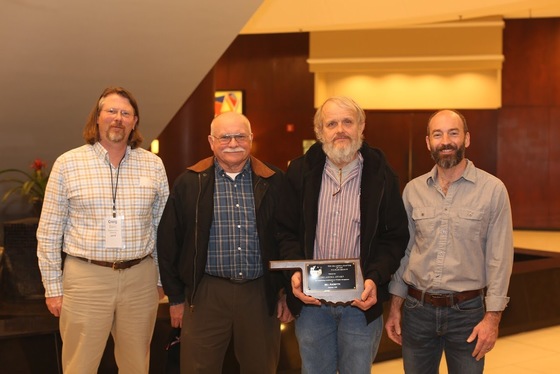100 Years of Management Helps Endangered Woodpecker
The Wildlife Department’s oldest management area
– the McCurtain County Wilderness Area – was created in 1918 and is home to
Oklahoma’s last remaining red-cockaded woodpecker population.
Learn more about
red-cockaded woodpeckers and the shortleaf pine trees on which they rely.
Species Spotlight: Banded Darter
Spring snorkeling in Ozark streams may reveal the colorful
banded darter, one of the most widely distributed darters in our nation. Named
for the green or brown bands that adorn the sides, this fish prefers swift
flowing waters with algae.
Learn more in the Wildlife Department's Field Guide
 "Oklahoma" award recipient Bill Puckette, third from left, was honored at a recent conference. Also pictured are Craig Davis, Steve Hensley and Richard Stark. Photo provided by The Wildlife Society.
Longtime Caver Honored for 37 Years of Bat Conservation
Bill Puckette, retired science teacher
and bat conservationist, was recently honored with the Oklahoma Chapter of The
Wildlife Society's most prestigious award at the 2018 Oklahoma Natural
Resources Conference. Puckette's work in the Ozark region has significantly
contributed to the advancement of cave and bat science and conservation in our
state.
“Bill has made truly indispensable and
irreplaceable contributions to cave and bat conservation in Oklahoma,” said
Richard Stark, biologist with the U.S. Fish and Wildlife Service’s Ozark
Plateau National Wildlife Refuge, a cave refuge established to help recover
federally listed cave species. “His conservation efforts have extended over 35
years and continue to this day.”
Puckette, a trained geologist, has
identified at least 90 caves that provide important habitat for Oklahoma's
wildlife and made design improvements to cave gates so that they are more
bat-friendly. He has also played a crucial role in monitoring efforts and
scientific studies of bats and other cave wildlife since 1981.
“His selfless commitment to conservation
is readily apparent,” Stark said. “And his love for conservation has and
continues to inspire those who work alongside him.”
Rediscover the Mixed Grass Prairie
All too often we overlook the natural beauty of Oklahoma’s
landscape because it waits just beyond our windows and backyards. Rediscover
the vast grasslands and vistas that are a central backdrop for our state’s
mixed-grass prairies this spring by making the short trek to one of western
Oklahoma’s many State Parks or Wildlife Management Areas.
The 13 driving loops
of the Great Plains Trail will take you to tried-and-true destinations that may
introduce you to the grassland songbirds that call in the early morning hours
and the lizards and skinks that sunbathe in the afternoon. Be sure to
pack a field guide, binoculars and camera along with your lunch!
Find destinations featuring the mixed-grass prairie along Oklahoma's Great Plains Trail
Night-flying Insects Surveyed in Osage County
The Wildlife Diversity Program recently partnered with
researchers at the University of New Hampshire to see if the rattlesnake master
borer moth, a candidate for listing under the Endangered Species Act, was
present at The Nature Conservancy’s Joseph H. Williams Tallgrass Prairie
Preserve in Osage County. While this particular moth remained undetected at the
site, surveys revealed the Preserve is a hotspot for insect biodiversity.
Learn more about this rare moth and how the researchers
surveyed the night-flying insects of the tallgrass prairie.
|